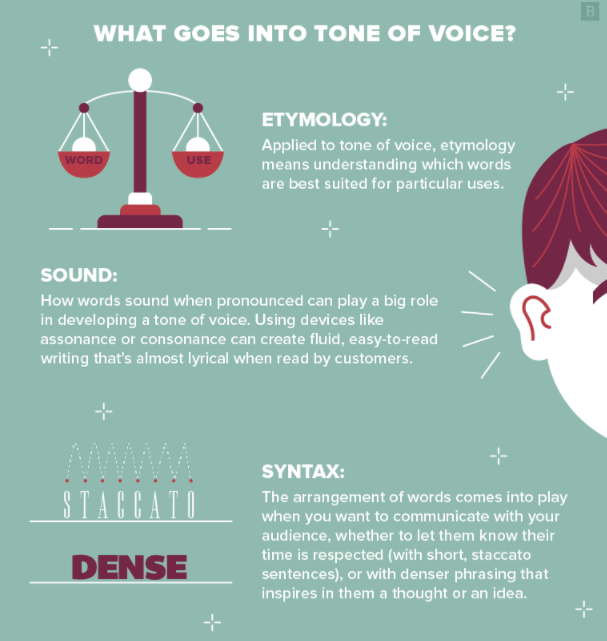How to Define Your Brand's Tone of Voice ?

The brands build the businesses that persist. The foremost beloved and longest-lasting companies tend to be those who understand this. They invest in building an identical presence and personality that’s immediately recognizable across their entire marketing strategy.
When people give some thought to brands, they often give some thought to their visual identity. However, there’s another element that usually gets overlooked: voice and tone.
More than ever, readers want to form an emotional reference to the brands they follow or give business to. they require to read content that speaks to them — not at them, and not past them. As a marketer, you ought to know your target market and the way to form that content click. But the task, as ever, could be a bit harder than it seems.
If your logo didn’t appear together with your content, could your audience identify the content as coming from your brand? Would someone viewing your content on different channels realize it all came from the identical brand?
If you’re not careful, you’ll be able to find yourself with a random assortment of voices and tones within the content produced across your marketing ecosystem that doesn’t provide a standardized picture of your brand, or maybe use the identical language consistently.
This inconsistent brand experience is more common as a company grows, and is usually exacerbated as external entities like freelancers and agencies get thrown into the brand’s content-creation mix.
What do you understand by the term Branding ?
Welcome to the age of name ubiquity, an era where everyone seems to be hellbent on telling a story. About what? Doesn’t matter.
There’s content to push, messages to craft, and no time to regret that “branding” has been pumped stuffed with hot air and ambiguity.
So, what exactly is branding? How should we define it?
For some, it’s visual. For others, it’s purely strategic. For all, it’s inescapable. In an exceedingly marketing culture that assaults our senses without mercy, there’s no such a thing as a brand-free interaction. We’re bobbing within the waters of an endless brand of ocean.
What is Brand Building?
Brand building is largely the method of generating interest in your business using powerful marketing techniques, your aim? to make a long-lasting image within the minds of your potential customers , you’ll build your brand using several online and offline marketing techniques:
- SEO
- PPC
- Email Marketing
- Content creation and marketing
- Social media marketing
- Adverts and promotion
- Traditional advertisement (for offline marketing)
What is Brand Voice ?
Brand voice is the consistent expression of a brand’s core messages, values, and personality through the purposeful use of words and prose styles. it’s the linguistic representation of all the individual elements that compose your brand and manage how that brand is perceived by the consumers who are tuned in to – or interact with – your brand and its products in any way.
Importance of Strong Brand Voice
Having a robust, consistent brand voice has become critical to a company’s survival during this age of constant distraction and endless scrolling. Without a robust brand voice, it’s nearly impossible for a corporation to achieve a position in a world already oversaturated with marketing messages.
A well-developed brand voice permeates everything from your social media posts, website copy, and emails, to your point of sale, and even your packaging. Essentially, every customer touchpoint provides a chance for prospects to come back into contact and become accustomed to this voice.
Specify Brand’s tone of voice
Enforcing branding across all your marketing materials might feel intimidating. But, it doesn’t have to be difficult. Follow this process to get the job done.
Review Your Company’s Mission Statement and Gather some sample of content
Your personality should reflect your values. And your values should be easily found in your mission statement. If your company has one , it should offer an honest start line for determining how your marketing efforts can connect your values to your brand.You want to cast a good net – gather everything from videos to websites, e-books to your social media calendar. Now, cast a critical eye on the content. Which of those examples could have come from any of your competitors? Set those aside. Your goal is to whittle your examples to atiny low group of pieces unique to your brand – samples of the brand voice you wish to embody. Print these examples and put them au fait on a whiteboard, grouping together pieces with an analogous feel.
Generate a Brand voice Chart

Research your Audience and take their view
Discover their gender, age, interests, education, job title — all the information you’ve got access to. Examine their demographic information by delving into Google Analytics and social networks analytics.
Then use this data to craft a portrait of your personality. Remember that your audience isn’t made up solely of buyers — your audience may include everyone from loyal customers to potential future customers finding you for the primary time.
A simple exercise to even better understand your audience is to grab a tiny low sample of your current best customers and research them:
- Choose five of your existing best customers.
- Search for each name in Google.
- Review their social network activity to understand.
Inspect Your Current Content, Messaging and communicate
If you have already got content or copy you’ve produced, it’s time to try and do a quick audit. Review your marketing assets, which can include the subsequent :
- Website
- Blog posts
- Social media posts
- Videos
- Print collateral
- In-store signage
- TV spots
- Radio ads
Then, note any common themes or consistencies in messaging and tone. Does your current voice suit your values and brand purpose? If not, how can it’s improved?
Pay particularly close attention to your best-performing pieces (whether these are blog posts, videos, website pages, social media posts, or other content). These may tell you the foremost about what resonates together with your audience.Before creating a tone of voice that matches your company, audit your existent content pieces and communication to determine what your brand feels like without delay.
To do so, make a listing of your top-performing (according to your content metrics) and best (in your opinion) content assets, and ask yourself if your current tone of voice:
- Fits the brand values you would like to communicate?
- Reflects your values described in your mission statement for your audience?
- Does it Correspond to your message architecture?
What goes into the tone of voice?

Culmination
Defining your brand’s tone of voice and establishing clear guidelines will help that tone move to the forefront in every content piece. This can be a key part of developing a content strategy that’s faithful to your vision and appears authentic to customers.
With a transparent idea of where your audience lives online and what topics they require to listen to more about, you’ll develop a vision of what your brand wants to mention and determine the way to use the correct language to induce this message across.
By keeping the same tone across all of your communications, your audience will gain a stronger sense of what the brand stands for and what commonalities you share along with your target market, hence, becoming a big part of SEO process.

